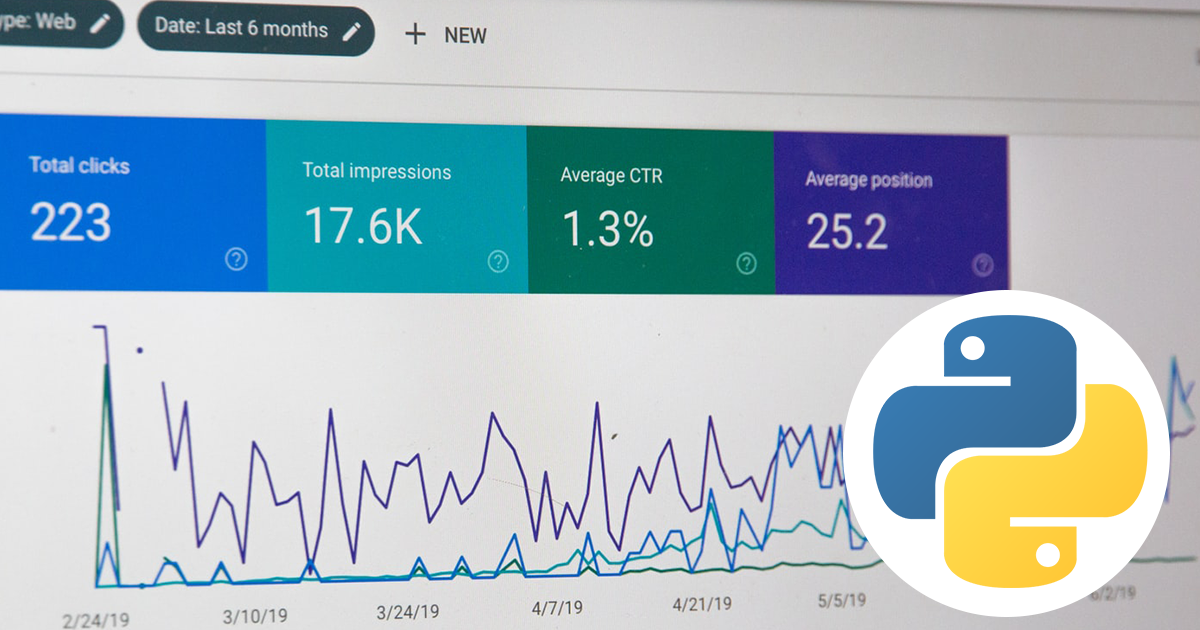6 Exciting Reasons To Choose Python For Data Analytics

Sr. Software Development Engineer
Skilled Angular and .NET developer, team leader for a healthcare insurance company.
August 22, 2019
No compilation step & easy debugging; Python is what programmers love for!
As a high-level, object-oriented programming language, Python is super flexible for experts. What about the beginners? Well, to get started with Python is so easy even for a beginner. Built with dynamic semantics and very extensive standard library, Python is quick to learn and hence reduces the cost of programming. The benefits of using Python as your programming platform are umpteen. As best suited for Rapid Application Development approaches, Python definitely finds its place in Big Data Analysis.
 Photo by Web Hosting on Unsplash
Photo by Web Hosting on Unsplash
Today's Business World and the Role of Big Data Analytics
In this fast-moving digital world what that matters in business in money! Businesses are going smart to attract more customers and generate improved ROIs using groundbreaking technologies like Big Data Analytics. The benefits of adopting Big Data Analytics for your businesses are umpteen. Cost Reduction, Faster & Better Business Decision Making, Improved Products & Services and Increased ROI are the exceptional benefits of adopting Big Data Analytics technologies for enterprises.
Now more and more organizations are using Big Data Analytics. From the Defense & Security sectors to healthcare industries and high-tech Manufacturing industries like Oil & Gas and textile industries, there is a stunning list of diverse industries who are into Big Data Analytics.
Python and Big Data Analytics: An Overview
Python can be used to develop both web and desktop applications of varying complexities. The ever-growing popularity of Python surpassing other programming languages is the evidence.
In a world stuffed with so much data, the Big Data analytics technologies are used to interpret such voluminous data, find the hidden patterns and convert them for the organizational benefits. Today’s world is a global market place where people are involved in buying and selling products and services irrespective of international territorial limits. Hadoop and other cloud-based data analytics tools help businesses discover the customer buying/selling patterns, market trends and even their preferences for accessing any service or product for their living.
Big Data Analytics is revolutionizing the way people think, buy, sell and utilize their money and choices in society. A massive amount of data is producing in every second and business leverage the power of Big Data Analytics to examine the customer patters to identify the customer decisions strategies so that they get a competitive edge over their contemporary business organizations. Competitive advantages that Big Data Analytics gives can be counted in terms of profit, market value and reputation. Now let us discuss every point on why we should choose Python for Big Data Analytics.
Open Source
Python is an open-source high-level programming language which uses a community-based development model. ‘Open source’ feature of Python makes it available ‘free’ for enterprises and programmers. Python can support windows as well as Linux platform and is also designed to provide multi-platform portability. Python has a good collection of open-source libraries including Natural Language Processing, Data manipulation, Machine Learning, Data Visualization, etc. Python also comes with built-in dynamic binding and dynamic typing features. In fact, Python can be defined as an interpreted high-level programming language most suitable for Rapid Application Development of apps. Code readability is another benefit of Python and this feature of Python is responsible for low-cost code maintenance.
Simplicity, Flexibility And Easy to Learn
Apart from its extensive feature-rich attributes, do you know what makes Python so popular among programmers and enterprises? It is nothing but the simplicity and the availability of built-in high-level data structures made it the most accepted platform for software apps. Python cleverly avoids the use of compilation step and the debugging of python apps tend to be easier. Another major advantage of Python is that the edit-test-debug cycle can be performed with great ease and is exceptionally fast.
Gone are the days of old-fashioned door to door sales techniques. In the modern world, customers purchase decisions have a strong influence on these AI-powered marketing techniques. For example, many retail giants are integrating Artificial Intelligence into their Customer Relation Management (CRM) system to respond to customer queries by providing answers for their questions using natural language, solving their problems, finding new business opportunities for the marketing team, etc. Alexa is an excellent example. Alexa uses AI and has natural language learning capability to process customers’ voice input.
With no compilation step included, Python is home to the binary form of Python interpreter and a proficient and rich standard library. Both the Python interpreter and standard library are freely distributed and doesn’t charge a single penny for using it on multiple platforms. It is to be noted that whenever a bad input or an error occurs, Python interpreter throws an exception. And if the intended program doesn’t catch the exception, what Python does is, it will print a trace. However, program code is thoroughly checked one line at a time by a source-level debugger. This source-level debugger checks for errors in the declaration of local and global variables, analysis of expressions, etc.
Python has comparatively a shallow learning curve. It is obvious for expert programming professionals to learn Python so easy. But the surprise is that, for beginners too, Python is fairly easy to learn. From installation to learning, the Python website provides a comprehensive list of resources for programmers. Starting with the selection of appropriate IDE’s and text editors for Python, everything is easy with Python.
Productivity and Scalability
Python produces light-weight programs. It means that Python requires fewer lines of codes to successfully execute a program. Python is designed to identify data types and automatically associate them. For Data Scientists, Data Analysts and Programmers, Python does ultimate favour by intelligently avoiding the need for carefully structuring Python syntax. Have you ever thought about any other programming languages can bring about equal advantages for three professionals - Data Scientists, Data Analysts and Programmers like Python does?
Dedicated Packages and Libraries
Python boasts of having an extensive standard library freely distributed for almost every platform. The standard library for Python is made available in it's binary or source code form and the major benefit associated with it is that they don’t charge for using it in all platforms. The extensive library of Python includes everything for internet protocols, OS interfaces, performing string operations and web services tools. Till now, Python holds libraries needed for various complex data analytics tasks. This makes the programs to reduce their total number of codes. Leaner codes, high compatibility and fast edit-test-debug cycle are the Real Plus of Python. Here is the list of frequently used, dedicated and open-source Python libraries that play a great role in Big Data Analytics:
- NumPy
- Scikit-learn
- SciPy
- SymPy
- mlpy
- Matplotlib
- Pandas,
- Theano
- PyBrain
- NetworkX.
Compatibility with Hadoop
As a popular Big data Analytics technology, Hadoop is a remarkable framework to perform Big Data Analytics for businesses. The analytics of such data patterns brings in considerable expenses for organizations. And Hadoop is a way to analyse data faster and make the best business decisions within the limited timeframe when compared to other Big data Analytics technologies. Python has high compatibility with Hadoop and Python has specially designed packages that offer direct access to access to HDFS - Hadoop Distributed File System known as Pydoop.
The significant purpose of Pydoop is to provide access to the distributed file system of Hadoop by acting as an interface that permits coding MapReduce programs in Python. The speciality of MapReduce programs is that it is written in simple Python language. MapReduce API is the application Program Interface or framework available to process large volumes of data against a Hadoop cluster. Hadoop MapReduce API is recognized as one of the reliable and fault-tolerant frameworks designed to process chunks of data that includes scheduling jobs, monitoring them and then re-executing the once failed jobs.
Active Open Community Support
Python can take pride in themselves for having increased and active community support, which is meant to provide adequate help 24/7. Big Data Analytics is a complex process and if Data Scientists are in need of any support or is seeking any new solutions, the active Python community of developers and engineers is there.
There is a splendid list of essential Analytics libraries made available for programmers to make their tasks simpler and efficient. In a Python community, Python developers can always go for any developers/experts contributed documentation and code or even mailing lists and Stack Overflow. The increasing popularity of Python is the one reason for the abundant availability of support documents and codes for Python users. As the popularity increases, more and more people add their contribution to the Python community which will be in turn beneficial for Python developers.
The complex nature of Big Data Analytics creates challenges in between and the support of such an active community is really helpful in achieving the desired business objectives. As Python has an open-source platform, developers and experts find it easy to add more complex codes that reduce the complications of Data Analysis.
Conclusion:
In a nutshell, we can say that Python is going to revolutionize the entire IT industry with its companionship with Big Data Analytics. The power couple, Python-Big Data Analytics, has the ability to carry out a precise analysis of the customer patterns thereby creating new opportunities for businesses.
According to leading agencies, many companies are into using Python for developing Big Data Analytics programs to improve their services and products to meet the customer requirements. Python powered Big Data Analytics Technologies like Hadoop after analyzing massive data patterns suggest businesses the more efficient and productive ways of doing businesses.













